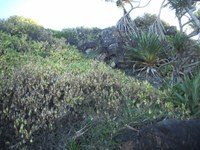Restoration of Threatened Ecological Communities and Species by Weed Removal at Smoky Cape
An 18 month (Nov 07 - May 09), $30 600 grant through the Australian Government Envirofund (project id: 64145). This project aimed to "protect native fauna and flora by weed removal. Activities to be undertaken are employing bush regeneration contractors to control weeds in an area of high biodiversity conservation value."
|
The activity undertaken during this project was bush regeneration by weed removal. Funding was used for the employment of bush regeneration contractors, with support and follow-up work carried out by volunteers. Targeted weeds were bitou, lantana, senna and white passionvine. The success of the project was the major reduction of weed infestation in the target areas. In particular, the area east of Smoky Cape lighthouse has seen bitou infestation reduce from 40-50% to below 3%. This spur, with an area of 3.4ha has shown spectacular resilience, and recent rains have lead to significant recruitment of native species. To the east-south-east, a large area (3.5ha) of steep slopes which were heavily bitou infested have had primary and some secondary work, and will now be relatively easily maintained and taken to a level of “search and destroy” only. The area of Dead Cow (3.1ha) has also seen significant progress, with the whole area having undergone primary work. |
Another success has been the use of splattergun application of herbicide to bitou; this has increased the speed with which a heavily infested area can be treated and thus decreased the relative cost as well as increasing the area we are able to manage. During the project, we changed the herbicide used in the splatterguns from glyphosate to metsulfuron methyl. This has considerably reduced costs (because the metsulfuron methyl is both cheaper and applied at lower concentration) and allowed the use of splattergun on smaller bitou plants surrounded by native grasses because it does not affect the grasses. This then improves worker efficiency because the area being treated can be done almost exclusively by splattergun,
|
and requires less handwork follow-up. The major challenges of the project were the difficult terrain and the isolation of the Dead Cow area requiring long walk-in times (at least half an hour in and 45 minutes out) which reduce the time available for bush regeneration. Although our group and contractors are familiar with the terrain, the steep slopes still make the work physically challenging. The highlight has been the almost total stabilisation of the previously mentioned spur north-east of the lighthouse. Another highlight has been the ongoing success of “visiting volunteer programme”. These volunteers contributed 370 hours to this project. Their presence not only supports our work directly but also helps to maintain morale amongst regular volunteers who see the effort the visitors put into “our” area and the pleasure they take out of it. Many of the visiting volunteers are also experienced bush regenerators, and the networking has mutual benefits in terms of increased experience and different solutions to shared problems. A highlight separate from, but relevant to this project was the presentation of a NSW Government Heritage Award to our group, “in recognition of an outstanding contribution to heritage conservation in New South Wales” in November 2008. |
It can be seen from table B (financial information) that an investment of $30600 by the government has produced work with a value exceeding $73000. This has resulted in primary weed removal in an area of approximately 10ha, with secondary follow-up over half of this area.





